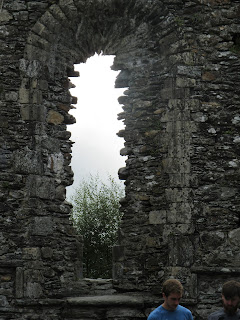Wednesday, September 7, 2016
Into the Wicklow Mountains, the Garden of Ireland and Back Into the Past at Glendalough
We began our last day in Ireland at the pick up point for Paddy Wagon Tours on O'Connell Street across from the Post Office, the site of the rebel headquarters during the troubles in 1916. We are old hands by now and Klep had made a trip to the Burger King for breakfast croissants and coffee. Since this was a half day tour, we knew there would be no "comfort" stop an hour out. We boarded the small bus, just seven of us and headed toward the sea through some of the more upscale areas of Dublin which include the American Embassy which was considered an eyesore when it was constructed in the 1960's but is now protected by the Preservation Society. Soon we saw the Irish Sea. We forget how close we are to the sea when we are in Center City with all the buildings and people around us. Our driver pointed out one of the round watch towers with a cannon on top left over from the long British rule.
We were headed toward the Wicklow Mountains which are known as the Gardens of Ireland. When Ireland was first settled, all the settlers stayed on the coast and the inland area was composed of vast woodlands which were the source for the wood (Irish Oak) which built the ships the British used to conquer most of the world. The mountains were also the source of gold, tin, and lead.
By 9:15, less than an hour into our trip, we got our first view of the mountains.
They were beautiful at a distance with the rolling farmlands at their base. We often forget that Ireland has a native language that is not English and the sign posts help to remind us of the Irish that the English tried for centuries to obliterate from the culture.
After we left the coastal highway and headed up the more narrow pass into the mountains, I discovered heather growing along side the road that our driver referred to as "hedder." It took me a few minutes to get used to this,
but I loved the fact that he identified things for us. The large ferns growing in great abundance are known as bracken and will soon lose their green color for the winter.
Much of the stone that was used to build great buildings were quarried from these mountains that geologists believe were formed over 60 million years ago.
No words can fully describe the feeling of standing on the mountain looking down at the lake that is now known as Lake Guiness because of the estate on edge of it. I do not know how anyone could stand in that location and gaze on the wonder of it all and not know that there is a God of creation. Peace encompasses the place. All of I could think of was, "Oh, Lord my God, when I in awesome wonder consider all...."
The cathedral is pretty much a ruin. A small part of the church stands. The look out tower in which the people would hide the valuables (including the scriptures) from marauders still stands tall. We shared our walk here with quite a lot of others, but we were still able to find little blocks of quiet in the woods where we could hear doves. One sweet episode in front of the ruins was a group of tourists who sang a song a Capella and sang it well.
We walked through a wooded area, across the stream and enjoyed seeing all the flowers, berries, and trees before headed back into Dublin.
We got out of the bus in front of the post office where we got stamps for post cards and looked at the exhibit of a leggo model of the "troubles" in 1916 which finally lead to the Republic of Ireland.
We gave in to our baser desires and found a fish and chips place.
Oh, Ireland!
Subscribe to:
Post Comments (Atom)














No comments:
Post a Comment